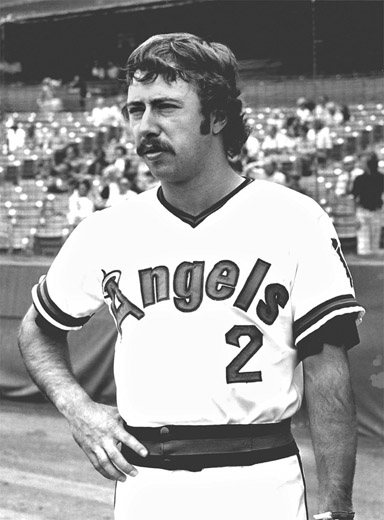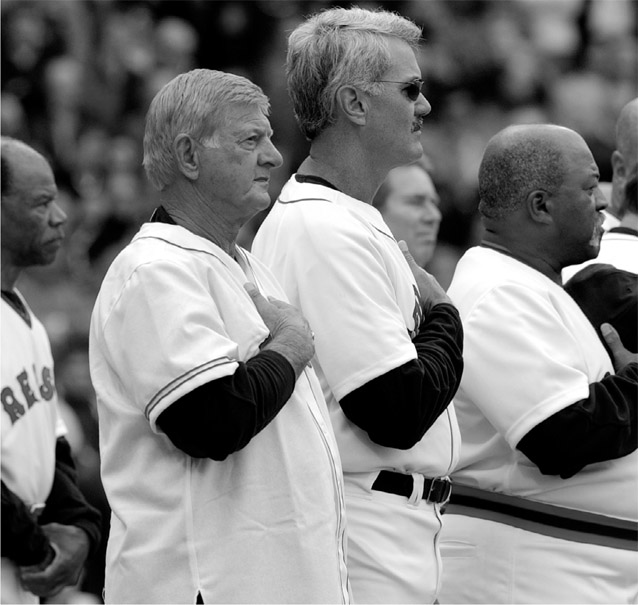

On deck in Anaheim.
Photo courtesy Los Angeles Angels of Anaheim Baseball Club
C H A P T E R F I F T E E N
In baseball a third baseman is probably the closest thing to a hockey goalie; the job calls for that kind of reaction time. Third base is the position that most requires first-step quickness.
Something like 90 percent of the ground balls to a third baseman are within three or four steps of where he is positioned before the pitch. And then consider that once the third baseman sets up, he might be 80 feet from the hitter. On any ball that has something on it, he doesn’t have time to take three or four steps—it is usually a crossover step and a dive.
Brooks Robinson was one of the best I ever saw. He didn’t have great speed, but he had first-step quickness, the ability to make diving plays, and he could make strong throws. On today’s Red Sox, Mike Lowell is as smooth as silk.
I don’t know if there’s one personality that works best for a third baseman. I’ve seen guys like George Brett, who was very intense, but then there was Robinson, who seemed so laid-back. Graig Nettles looked as casual as could be. He’d grab the ball and flip it over to first sidearm and seem to get the runner by half a step every time.
The most difficult play for a third baseman is handling a slow roller. First of all he’s got to decide: Do I use the glove or do I barehand the ball? Then, once he gets the ball, he’s usually at a difficult angle to first base. He’s got to open up and throw across his body to first base, and he’s got to throw a strike.
Remy Says: Watch This
Looking Down the Gun Barrel
One of the third baseman’s nightmares is to charge in toward home plate expecting a bunt, only to find that the batter has pulled the bat back to take a swing at the ball. You don’t see that very often. And you don’t want to see it very often if you’re a third baseman, that’s for sure.
If the guy swings away, the third baseman is either going to get it in the throat or it’s going to go by him; it’s not likely he’s going to catch it. He probably hopes it goes by.
The throw from this kind of play is usually made off-balance, and if the third baseman throws sidearm, he’s got to know that the ball usually tails back in, so he’s got to adjust for that in his throw to first base.
And then there are diving plays. The tough part is not the dive or the catch, it’s the third baseman getting back to his feet, getting lined up, and making an accurate throw to first base. Another tough play is going to the right down the line and then making a long throw across the diamond to first base. On bunt plays, as with the slow roller, he needs to be able to charge the ball properly and make off-balance throws to first base.
When it comes to making a play at the plate from third base, the challenge the fielder faces depends on where the ball is hit. If it is hit straight down the line, that becomes a difficult play because the runner heading for the plate may be blocking the throw. A third baseman grabbing a ball hit down the line looks up and says to himself, “Uh-oh. I can’t see the catcher.”
It’s very dangerous to throw the ball over the head of the runner: It can sail over the catcher or make him stand up and allow the runner to slide in safely under the tag. The proper play is for the catcher to act like a first baseman and stretch out so the third baseman can see him.
The third baseman also has to make some split-second decisions about where to throw the ball. Let’s say bases are loaded and there’s a grounder to third. Depending on how the ball is hit and the speed of the batter, the third baseman has to decide whether to throw home or go for a double play. It’s not automatic to throw to home plate unless it is essential to stop that run from scoring. Usually, if the third baseman’s momentum is toward second base and the batter is not that fast, he will go for the double play at second and first.
These are instinctive things that come out of years and years of playing. Every fielder has to be thinking before every pitch, “What am I going to do if this ball is hit to me?” There’s usually a plan A and plan B.
Third basemen are at a disadvantage in the infield because they can’t see the catcher’s signs to the pitcher. They sometimes can get help from the shortstop; for example, if the pitch is going to be a breaking ball, the shortstop might whistle at him, call his name, or open his mouth.
The third baseman usually wants to know if an off-speed pitch is coming. He doesn’t need to know if it’s a fastball because he’s already set up for that. If he knows an off-speed pitch is coming, he might take another step toward the line if a right-hander is at the plate or a step away from the line if a lefty is at bat. The assumption, of course, is that a batter will swing early at an off-speed pitch and pull it.
Remy’s Top Dawgs
Mike Lowell was the smoothest infielder on Boston’s 2007 team; nobody else even came close.
Every position is different, but Lowell showed he knew the hitters and could be in position, knowing when to play in or play back, and knew how to play the bad hop. Third base requires first step quickness, jumping in on the ball.
Lowell just does it naturally, where other guys have to work harder at it. He’s better than A-Rod, who is just average at third.
Around the league, I still think Derek Jeter is among the best at shortstop. Placido Polanco is unbelievable at second base for the Tigers. At first base, of course, there’s Boston’s own Kevin Youkilis. The kid over at Minnesota, Justin Morneau, is pretty good.

Four all-time-great Red Sox favorites (from left, Tommy Harper, Carl Yastrzemski, Dwight Evans, Luis Tiant—each of them an All-Star) attend Opening Day 2005 at Fenway.
Photo courtesy AP
There are pickoff plays designed for a snap throw by the catcher to the third baseman. Everyone has to be really careful because the runner is just 90 feet away from home plate. It’s not like making an error at first or second; if a pickoff gets screwed up at third base, that runner is going to score.
Rundowns are also tough around third base because if the ball gets away, the run scores. The team on the field has to make sure the runner is going back toward third base. In a rundown the runner should never be chased toward home. If there’s a bobble while the runner is headed to the plate, he’s almost certain to score; if he’s headed back to third base, that could limit the damage.